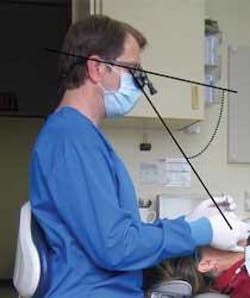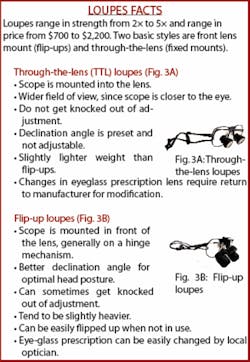Neck health: the three ergonomic criteria for loupes selection
by Bethany Valachi, MS, PT, CEAS
For more on this topic, go to www.dentaleconomics.com and search using the following key words: ergonomic neck health, loupes, declination angle, frame size, musculoskeletal health.
Dentists generally purchase loupes for two reasons: to enhance visual acuity and treatment quality, or to improve working posture and comfort. Just as scope quality and clarity vary widely among manufacturers, so do ergonomic desings. While none of today's loupe systems enable perfectly neutral head posture (ear—over—shoulder), well—designed loupes may significantly improve poor working postures that contribute to musculoskeletal disorders and clinician discomfort. Unfortunately, there are also non—ergonomic loupes on the market today that can actually worsen musculoskeletal health. Therefore, it is important that dentists be well—educated and prudent in their selection.
The three essential ergonomic factors when purchasing loupes are working distance, declination angle, and frame size. Together these variables should enable a forward head posture of 20 degrees or less (Fig. 1).
1 Working distance is the distance from the eyes to the work area. The most common problem I observe clinically is that this distance is often measured too short, which results in excessive neck flexion or hunching. At convention booths, mounted typodonts cannot take into consideration the thickness of your patient chair or your preferred working height. A discrepancy of just a couple of inches can have a significant impact on comfort and health. It may be advantageous to purchase the scopes at a convention to receive the "show discount," and then tell the representative you will contact them with the accurate working distance measurement taken in your operatory.To measure the working distance in your operatory you need a patient in the chair, with the mouth at or very slightly above your elbow level. While looking into the patient's mouth, and hands/arms simulating a treatment position, have someone view you from the side and measure the distance from your eye to the work surface. Do this in three treatment positions around the patient's head (for example, 12 o'clock, 10 o'clock and 8 o'clock positions). Working distances will vary for shorter operators (14 inches or less) to very tall operators (more than 20 inches). Therefore, working distance should be tailored to the individual.
You should also consider the depth of field, or working range. This is the range that an object will stay in focus as you move closer and farther from the oral cavity. This varies with different magnification strengths — the higher the magnification, the smaller the range. In consultations and at our dental school, I've observed loupe working ranges that allow the operator to hunch over the patient while the object stays in focus. If the object is still in focus when the operator sits up straight, this means the operator has "drifted" to the closest end of their working range. This is why I encourage the working distance to be measured slightly long.
2 Declination angle is the angle that your eyes are inclined downward toward the work area (Fig. 1). This angle should be steep enough to help you attain a comfortable working position with minimal forward head posture (20 degrees or less). The farther the head is positioned forward to see through the loupes, the greater the strain on the neck. Too extreme of a downward declination angle can cause eye strain; however, I have rarely observed this problem clinically. By far the predominant problem regarding declination angles is insufficient (small) angles that force the operator to assume unhealthy working postures.Since glasses rest differently on each face, the same pair of loupes may have a slightly different declination angle from one person to the next, depending on interpupillary distance, nose bridge height, and other variables. However, the declination angle that various manufacturers offer varies dramatically, and can either benefit or worsen your musculoskeletal health. Generally, flip—up—style loupes allow for a steeper declination angle and more neutral head posture compared to TTL loupes. Therefore it's a good idea, when ordering TTL loupes, to request the steepest declination angle possible.
Even when ordering a large frame, some manufacturers may not mount the scope as low as needed. Buyers should always request that the TTL scope be placed as low in the large frame as possible.
Selecting telescopes
General guidelines for magnification strength are as follows: for general dentists, 2.5×to 3.5×; for endodontists/periodontists, 3.5× to 4.5× or higher. Keep in mind that high powered scopes create a shorter depth of field, which may make working in multiple areas of the mouth difffcult. Work with your scope representative to ensure proper measurement, adjustment, and working posture. It's not unusual for new loupes to need slight adjustments, so be sure to evaluate your new scopes carefully and do not hesitate to contact the manufacturer's technical support for adjustments. Loupes require an accommodation period. Wear your loupes for no longer than a couple of bhours the first few days, and gradually increase wearing time over a five– to 10–day period to become accustomed to the new acuity, posture, and field of vision that magnification offers. Speeding this process can lead to headaches.
Wisely selected loupes will not only improve quality of care, but will enable better working posture and more comfort. Consideration of these three ergonomic criteria can have significant ramifications for your musculoskeletal health and career longevity.
References available upon request.
Bethany Valachi, PT, MS, CEAS, is a physical therapist, dental ergonomic consultant, and author of the new book, "Practice Dentistry Pain—Free: Evidence—Based Strategies to Prevent Pain and Extend Your Career." She is president of Posturedontics®, a company that provides research—based dental ergonomic education, and is clinical instructor of ergonomics at OHSU School of Dentistry in Portland, Ore. Valachi lectures internationally to dental organizations and has produced exercise videos specifically for dental professionals. Valachi offers free, unbiased dental loupe evaluations on her Web site located at www.posturedontics.com.



